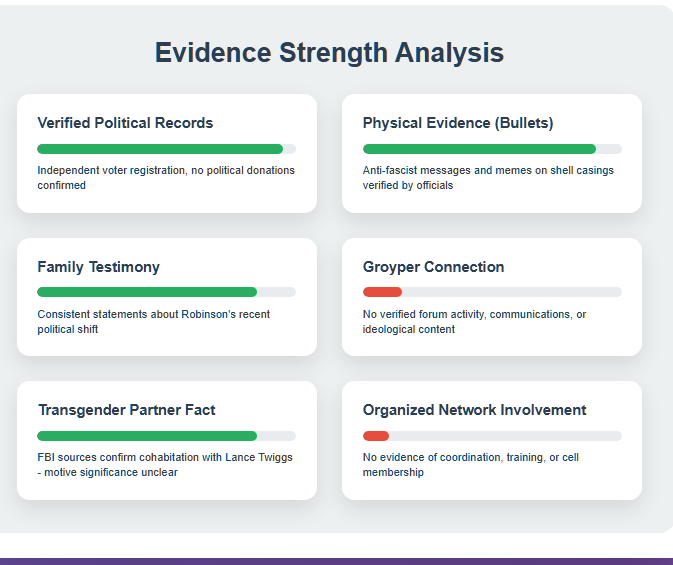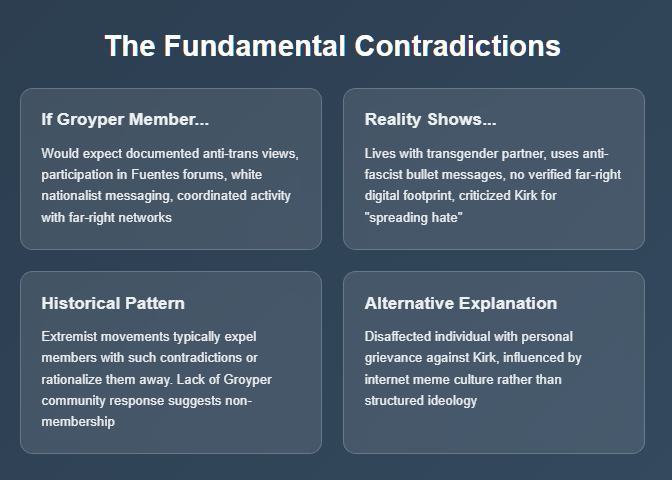Address
304 North Cardinal St.
Dorchester Center, MA 02124
Work Hours
Monday to Friday: 7AM - 7PM
Weekend: 10AM - 5PM

Law enforcement sources first brought Robinson’s cohabitation with a transgender person to light via a Fox News report. According to Fox (citing unnamed FBI officials), Robinson, 22, had been in a “romantic relationship” with an unnamed individual (a male-to-female transgender person), and they shared an apartment in St. George, Utah. The partner was said to be fully cooperating and unaware of any plot. Local reports echoed this, identifying the flatmate as “Lance Twiggs” and confirming a long-term roommate status. Twiggs’s own family told reporters they had no knowledge of politics or transition status, and no official source confirmed Twiggs was the trans partner. While the FBI has not yet confirmed the trans lover report, a number of mainstream outlets have independently corroborated the transgender-partner detail.

That said, and critically, no credible source has yet tied the roommate detail to Robinson’s motive. Fox made no explicit ideological link and stated the partner “had no idea Robinson was planning” the attack. Utah’s governor, Spencer Cox, and federal agents instead described Robinson’s own comments about Kirk. They reported that family and friends said Robinson had “recently become more political” and openly disliked Kirk. Indeed, Cox said his family quoted him criticizing Kirk as “spreading hate” at a dinner table discussion. These remarks align with Robinson being aggrieved by Kirk’s conservatism, not with any personal link to a roommate. In other words, all authoritative clues about his motive come from Robinson’s own statements about Kirk, not from his domestic situation. Thus, from the evidence available, Robinson’s personal relationship with a transgender person appears incidental — it has not been identified as a trigger or planning factor in the attack. That said, the memes found on the bullets do suggest that Charlie Kirk shooter Tyler Robinson may have been associated with the Groyper and furry cultures, and an image of Robinson’s partner, Lance Twiggs, appears to show them wearing “furry” garb.

Far-right subcultures often preach rigid ideology, so a member with a trans partner would be an obvious contradiction. However, modern extremist movements can be fluid about such contradictions. Observers note that today’s alt-right groups use irony and trolling, making it hard to know when statements are sincerevanityfair.com. Dell Cameron in Vanity Fair argues that online extremists “play characters” – they call the world a “forum board” where hateful remarks can be just performance. In practice, this “post-truth” persona means personal details like a transgender partner might simply be shrugged off or labeled a “meme” if revealed, rather than prompting ideological purges. Historically, movements often protect valuable members despite contradictions (for example, Nazi leader Ernst Röhm’s homosexuality was initially tolerated until politics demanded his removal). We found no documented case of a far-right member living openly with a trans partner; such situations would likely cause infighting or accusations of deceit within far-right circles. In sum, extremist subcultures generally do not publicly reconcile such contradictions – they either rationalize them away or expel the individual if the secret leaks. Experts caution that without full context, one cannot assume Robinson’s roommate detail refutes or confirms any ideology. It simply highlights that real people can defy ideology neatly: he might have embraced or tolerated someone close who defies far-right norms, or he might have downplayed it. To date, no credible evidence suggests the trans relationship was part of an ideology or operational motive but there is also no evidence to suggest that it can be eliminated as a portion of Robinson’s motive. Contemporary analysis (and Robinson’s own conduct) suggests instead an unconventional personal profile rather than a textbook Groyper identity. Having a trans partner would indeed be in line with this type of unconventional personal profile.

Investigators and analysts have so far found virtually no trace of Robinson publicly engaging in niche right-wing networks. Utah officials noted he had “virtually no online footprint that could be immediately identified.” For instance, Wired reports that social media accounts of his family members were quickly closed and any found photos did not reveal ideology. In addition, Robinson’s Discord communications (via his roommate) focused solely on logistics (retrieving a rifle, stashing it, engraving bullets shot from the Mauser rifle used to kill Charle Kirk) — no discussion of politics or extremist manifestos was evident. Discord itself confirmed to NBC News that Cox’s cited messages were actually the roommate recounting what Robinson had said in writing. Crucially, there is no verified online content linking him to Nick Fuentes or Groyper channels. A rumored Facebook photo showng a Pepe Frog “Groyper meme” pose fueled speculation, but this is unverified and could easily be an internet joke or coincidental pose. We found no confirmed handles, chat logs, or posts in any Groypers or Fuentes forums attributed to Robinson.
Instead, the Digital Footprint that surfaced is more consistent with online meme culture or left-wing tropes. Bullet casings engraved by the suspect were filled with internet memes and anti-fascist phrases. For example, one bullet bore the Italian lyrics “Bella ciao… ciao ciao” – a famous anti-fascist folk song made popular by Netflix’s Money Heist. Another read “If you read this, you are gay, LMAO,” seemingly a juvenile taunt rather than an ideological slogan. A third inscription translated to “Hey fascist! Catch!”. Analysts note these are internet in-jokes rather than Groypers’ coded language. Indeed, Cameron argues none of Robinson’s known phrases are recognized as extremist dog-whistles; they look like “contextless internet” memes. Similarly, Wired quotes Cox saying casings had “meme culture and anti-fascism” engravings, which matches anti-right slogans (the term “fascist” is mainstream left’s epithet for conservatives).
No domain registrations, chat logs or metadata have emerged tying Robinson to known far-right events. Early social-media chatter pointed out that no record of Robinson donating to Trump or other right-wing campaigns exists. In fact, Utah records show him registered independent/inactive and not voting in recent elections. Fact-checks debunked social-media claims: an online “Grok” report confirmed the lone “Tyler Robinson” who donated to Trump in 2020 lived a different street, not the shooter. Altogether, Robinson’s online remnants (as far as we can see from credible sources) align more with a disaffected young man engrossed in meme culture than with any formal Groyper network or Nick Fuentes community. This suggests his online footprint is a blend of gaming and internet subculture — not an orthodox far-right trajectory.

Utah state records definitively show Robinson was registered to vote without any party affiliation, and he was marked inactive – meaning he hadn’t voted in at least the last two general elections. This matches widely-reported summaries: as Al Jazeera notes, “he is not affiliated with a political party, and he didn’t vote in the two most recent general elections.” NBC also confirms his voter status as inactive/independent. No records link him to any political organization, campaign, or donation. For example, social-media sleuthing about contributions to Far-Right PACs found nothing relevant to his name. Claims he gave to Trump’s campaign were false coincidences, and there is similarly no evidence of any donations or volunteer work for Turning Point USA, Nick Fuentes, or any extremist cause. In short, Robinson’s civic records suggest minimal formal political engagement.
Those emphasizing Robinson’s lack of voting and party ties argue that this undermines the “committed Groyper assassin” narrative. Indeed, not voting and having no party might seem at odds with an activist ideology, yet it’s also common for young adults to be apolitical. It does weigh against him being a practiced far-right organizer. Conversely, the same records show Robinson’s parents are long-time Republicans, and his family sits comfortably within Utah’s conservative milieu. But there’s no sign he followed them into organized activity. Investigators and analysts have highlighted this: the fact-checkers emphasize he never showed up on any voter rolls for party candidates. Thus, civic records do not support a picture of Robinson as a dedicated far-right militant. Instead, they portray him as a politically quiet individual who recently expressed personal disdain for Kirk.
Timeline of Early Narratives: Immediately after the shooting (Wednesday, Sept 10), reactions streamed in with no official suspect identified. Right-wing media figures and influencers instantly framed the murder as a partisan attack. Steve Bannon declared on War Room that “Charlie Kirk is a casualty of war… We are at war in this country”. Elon Musk wrote on X that “our choice is to fight or die”, and Fox’s Jesse Watters thundered that “we know which direction we’re going” and that such violence “ends now”. Trump himself blamed “the radical left” for the shooting, earlier likening Kirk’s death to leftist terrorism. In line with this, Reuters observed, many Trump supporters blamed the political left and sought vengeance (one post likened it to “Reichstag Fire” and another urged ending democracy). Social media buzz included conspiracy rumors and misidentified suspects, as NBC documented. Prominent Democrats were blamed in public statements (Rep. Mace said “Democrats own what happened” on the House floor) before any facts were known.
By Thursday, misinformation had run rampant. NBC’s fact-check thread notes that within the first 48 hours, claims flew that Robinson was a Republican or even a DSA member – all of which were false. At the same time, Gov. Cox announced a reward and law enforcement continued their manhunt, but official details remained slim. On social media, amateur OSINTers compared images of Robinson to known far-right memes, feeding the Groyper rumor. One viral comparison (black Adidas track suit squat) echoed a known Pepe/Groyper meme. Yet even as the Groyper angle percolated online, mainstream outlets urged caution: no outlet confirmed Robinson’s ideology until evidence came.

On Sept. 12 (72 hours after the shooting), officials arrested Tyler Robinson and began sharing verified facts. Cox’s briefing confirmed a family tip led to Robinson, and emphasized what the family said: Robinson “had recently become more political” and openly disliked Kirk. This was after George Zinn, a man now accused of possessing CSAM, falsely confessed to the Kirk shooting at the scene. This narrative matched NBC’s earlier summarization that Robinson criticized Kirk as “full of hate.” Crucially, investigators also revealed physical evidence: shell casings from the scene bore the internet-meme inscriptions discussed above. That detail quickly reoriented many outlets toward an “anti-fascist meme” story: Reuters noted one cartridge saying “Hey fascist! Catch!,” and called it a left-wing message on a bullet. These engraved messages – along with news that Robinson was apolitical in his voting – undermined the earlier left-vs-right narrative.
In sum, two opposing frames emerged. Fox and sympathetic voices pushed a “leftist assassin” narrative: the shooter was radicalized online by anti-Kirk agitation, with the trans partner detail underscoring a far-left milieu. By contrast, fact-based outlets emphasized Robinson’s lack of formal ties and the unusual bullet messaging. For example, NBC and Reuters highlighted that Robinson was unregistered, unknown to police, and that his ammo inscriptions were anti-fascist.
By the weekend, the anti-fascist bullet inscriptions became a focal point. The evidence of “Bella ciao” and “if you read this you are gay” stuck because it was hard to spin as far-right code. Meanwhile, the Tyler Robinson Groyper photo speculation was widely reported only by various media; it was rebutted or simply ignored by authorities. Official lines settled on: Robinson “acted alone” (per Cox) and gravitated to the far-left memes, not to Fuentes. In particular, Cox himself countered the idea of a left motive by stressing how many times Robinson simply took those memes at face value, not as political ideology.
The early 72 hours thus saw a classic case of information laundering. Unverified details were floated on sympathetic platforms, gaining traction through social media echo chambers. Each detail was then picked up or refuted by different camps. Throughout, fact-checkers worked to debunk false narratives (registered Republican? DSA member? video of other shooter?). By contrast, Republicans and Fox leaped on anything that fit their expectation of a leftist perpetrator (for example, rushing to claim the shooter was Don Lemon’s wife “this must be wife of CNN anchor” — ironically a false conspiracy about them incorrectly blaming Democrats). Similarly, Democrat audiences (before arrests) assumed a GOP shooter and spread misinformation in reverse. This churn meant the true verified information (witness accounts, family statements, ballistic evidence) was often overwhelmed by competing rumors in the first days.
After the dust settled: The official narrative coalesced into something narrower: Robinson was a lone gunman with anti-Kirk animus and an eclectic meme-based style, not a cell member. However, by then each side had built a preferred story. On the Right, the idea of a leftist assassin “played to base fears” of an emboldened “demonic” left. On the Left, the focus on Robinson’s bullet engravings and inactive voter record was used to downplay conspiratorial blames. Ultimately, major news outlets (Reuters, Guardian, BBC, AP) emphasized verifiable details: Robinson’s background, the engraved bullets, the discord logs, and the lack of prior activism. The trans-roommate detail remained largely on Fox and allied sites. Meanwhile, political figures shifted their narratives post-arrest: some conservatives still hint at conspiracies (liberal media cover-ups), while liberals have pointed out how Kirk’s own rhetoric (against minorities and trans people) looms large in Robinson’s known grievances.

History offers mixed lessons on ideological doubles. Many extremist movements have had notable cases of personal hypocrisy – a fierce homophobe later exposed as gay, a virulent anti-semite discovered with a Jewish partner, etc. Those cases typically become scandals that the movement may suppress or rationalize away. For example, 1930s German Nazis initially tolerated SA leader Ernst Röhm’s homosexuality for his military usefulness, but later used it as propaganda to purge him in the Night of the Long Knives. In U.S. far-right history, figures like Senator Joseph McCarthy privately skirted demonic conspiracies they publicly hunted. The pattern is that extremists often deny or attack contradictions; only when someone is caught in an extreme lie do supporters lose trust.

In Robinson’s case, the “contradiction” (living with a trans partner while allegedly sympathizing with anti-trans rhetoric) would seem glaring if he truly were a committed Groyper. However, none of our sources indicates he publicly espoused anti-trans views — quite the contrary, the only person in his life known for targeting trans people was Charlie Kirk, whom Robinson disliked. This suggests Robinson’s “far-right” behavior may have been limited to animosity towards Kirk, not a full ideological commitment – although his use of memes might suggest otherwise. From the outside, Robinson does not clearly fit the profile of a closet extremist. Instead, his case resembles those of some lone-wolf attackers motivated by personal resentment: like the 2016 Dallas shooter (a Black Army vet angry at police, not an ISIS member) or the 2022 Kansas shooter who idolized a spree killer. In each, ideological extremist labels were a poor fit compared to personal vendettas.
Given the available evidence, Robinson’s situation seems closer to personal grievance than to a “closeted Groyper” – although the latter remains plausible He apparently targeted Kirk for Kirk’s own viewpoints (and possibly Kirk’s anti-trans stance), not because he secretly subscribed to Nick Fuentes’ ideology. His bullet casings feature antifascist memes, which undercut the typical symbols a Groypers follower would use (there are no Fuentes slogans or white nationalist phrases among them). This mirrors other incidents where attackers used ironically opposite slogans as misdirection. Even experts quoted by media note that the meme-laden bullets fit into a vague “internet meme subculture” rather than explicit ideological warfare.
We did not find any historical example exactly like a far-right activist discovered to be roommates with or the lover of a trans person – likely because such a scenario would have generated its own news, and because trans people have only truly entered the media spotlight in recent years. What we do see is that extremist communities often excommunicate or denounce insiders when these contradictions emerge. If Robinson were a known Groyper, the community’s likely reaction would be to distance itself, branding him a plant or traitor. In practice, the topic never reached Groyper leadership channels publicly; Fuentes or his deputies have not (as of our latest research) commented. This absence suggests either they did not consider Robinson one of their own, or they ignored the story entirely. In any case, Robinson’s documented actions and context fit better with an unstable lone actor who may quite simply have been deeply confused in terms of finding his identity.
Our research yields no conclusive evidence linking Robinson to Nick Fuentes or the Groyper movement but the possibility remains. Confirmed facts – voter rolls, family statements, bullet inscriptions – point toward a left-leaning meme user with personal animus, not a far-right ideologue but the ideological spectrum is not linear. Rumored ties (photos, memes, social-media chatter) remain unverified and somewhat contradictory. The “trans roommate” has not yet stood up as a motive in any credible or realist parsimonious fashion but still be important as Kirk was anti-trans. In fact, multiple independent fact-checks and mainstream reports align on one clear narrative: the suspect was a politically disengaged Utah youth who recently fixated on Kirk and used online meme language, not a member of an organized far-right cell. It remains to determine, however, whether the newly discovered trans variables had any explanatory role to play in this case.
In OSINT terms, the Robinson case underscores the need to distinguish verifiable evidence from noise. Official records and forensic evidence strongly suggest Robinson’s motives were personal, not dictated by any structured extremist ideology. The surrounding controversy over the Groyper label or transgender have so far proven to lack full foundation. Ultimately, Robinson’s profile matches a contradiction – living with a trans person while targeting an anti-trans conservative – that is hard to reconcile under a single ideological banner. Historically, when extremists have such contradictions, the movement itself usually either collapses the inconsistency or declares the person not a true believer. So far, without solid evidence, the mainstream narrative remains that Robinson was a disaffected lone wolf acting on personal hatred of Charlie Kirk, rather than a committed Groyper with a clandestine conservative network.

[…] with ideological phrases. According to a law enforcement bulletin cited by the Wall Street Journal, the rounds in the rifle bore inscriptions referencing transgender and anti-fascist slogans. In other words, the killer might have scrawled culture-war catchphrases on the bullets – a […]
[…] Kimmel: teachers, professors and corporate employees across the country were fired or suspended for online posts about Kirk. This juxtaposition reveals a broader right‑wing practice of invoking free speech to defend their […]
[…] 6. Tampering With a Witness (Third‑Degree Felonies): Robinson allegedly urged his trans roommate/partner to delete incriminating text messages and later instructed the roommate to remain silent when […]